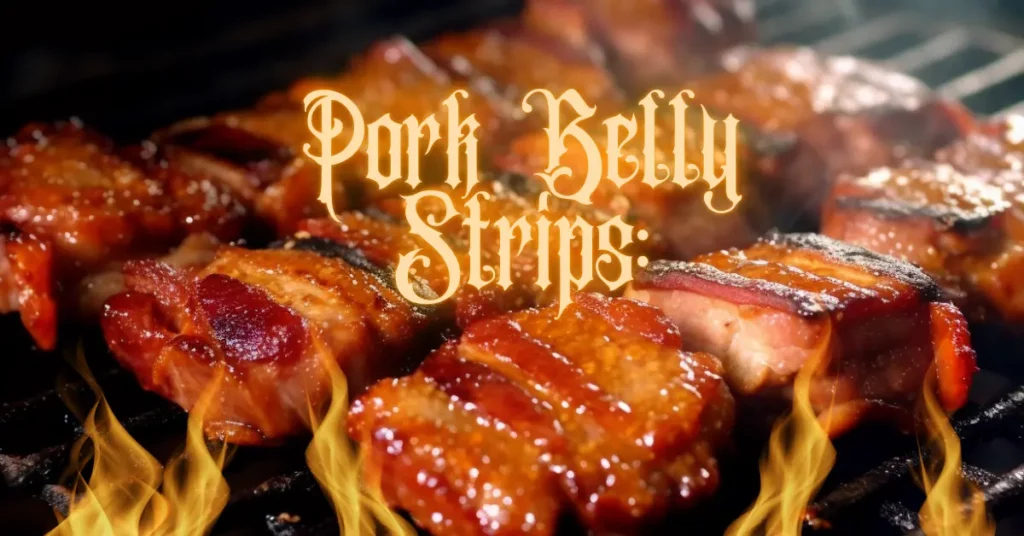This post may contain affiliate links. If you use these links to buy something we may earn a small commission. Thanks.
Smoked pork belly strips are a delicious and flavorful treat that every barbecue enthusiast should try. Whether you enjoy them as crispy bacon-like bites, in sandwiches, or as a standalone dish, the rich smoky aroma combined with the melt-in-your-mouth texture makes them irresistible. However, achieving the perfect balance of smokiness, tenderness, and crispiness requires patience and the right technique.
One of the most common questions among beginners and seasoned smokers alike is: How long should you smoke pork belly strips? The answer depends on various factors, including the thickness of the strips, the smoker’s temperature, and your desired texture. In this guide, we’ll walk you through every step of the process to help you master the art of smoking pork belly strips.
Preparation Steps
Choosing the Right Pork Belly
Before you begin smoking, selecting high-quality pork belly is crucial. Look for a piece with a good balance of meat and fat. The fat content enhances juiciness and creates a tender, flavorful result.
Trimming and Slicing
- Thickness Matters: The thickness of your pork belly strips directly affects the smoking time. Strips about ½ inch thick will smoke faster (around 2–3 hours), while thicker strips (1 inch or more) may take 3–4 hours.
- Uniform Slicing: Cut the pork belly into even strips to ensure uniform cooking. Uneven slices can lead to inconsistent textures.
Seasoning Options
Pork belly is incredibly versatile and pairs well with both dry rubs and marinades. Some popular seasoning options include:
- Simple Salt and Pepper: Enhances the natural pork flavors.
- Sweet and Spicy Rub: Brown sugar, smoked paprika, cayenne pepper, and garlic powder.
- Asian-Inspired Marinade: Soy sauce, honey, ginger, and garlic.
- Maple or Honey Glaze: Adds a caramelized, slightly sweet touch.
Let the seasoned pork belly rest for at least 30 minutes to allow the flavors to penetrate the meat. For deeper flavor infusion, refrigerate overnight.

Smoking Process
Best Type of Wood for Smoking
The choice of wood significantly impacts the final flavor. Some of the best wood options for smoking pork belly strips include:
- Hickory: Strong, smoky flavor perfect for a bacon-like taste.
- Applewood: Mild and slightly sweet, great for a balanced profile.
- Cherry: Enhances color and adds a subtle sweetness.
- Maple: Brings a light, caramelized touch.
Optimal Smoker Temperature
For the best results, maintain your smoker at 225°F–250°F. This low-and-slow approach ensures the fat renders properly, making the meat tender and flavorful.
Time Estimates Based on Thickness
- Thin Strips (½ inch): 2–3 hours
- Thicker Strips (1 inch+): 3–4 hours
When to Wrap (Optional)
Some pitmasters prefer wrapping pork belly strips in butcher paper or foil once they hit 160°F to retain moisture and enhance tenderness. However, if you want a crispier texture, leave them unwrapped.
Spritzing and Basting
To keep the pork belly strips moist, consider spritzing them every 45 minutes with:
- Apple cider vinegar
- Apple juice
- A mix of water and Worcestershire sauce
For an added layer of flavor, brush on a light glaze (such as honey or maple syrup) during the last 30 minutes of smoking.
Internal Temperature Guidelines
Using a meat thermometer is the most accurate way to determine doneness. Aim for the following internal temperatures:
- At least 190°F: Tender and juicy
- 200°F–205°F: Ultimate melt-in-your-mouth texture
Resting and Serving
How Long to Let the Pork Belly Rest
Once the pork belly strips reach the desired internal temperature, let them rest for 10–15 minutes before serving. This allows the juices to redistribute, ensuring a flavorful bite.
Slicing and Serving Suggestions
Smoked pork belly strips can be served in various ways:
- Crispy Bites: Cook further on high heat for a bacon-like texture.
- Sandwiches and Sliders: Pair with soft brioche buns, coleslaw, and barbecue sauce.
- Tacos: Top with fresh cilantro, pickled onions, and a squeeze of lime.
- Standalone: Serve with dipping sauces such as honey mustard or bourbon glaze.
Recommended Pairings
- Side Dishes: Mac and cheese, baked beans, cornbread, coleslaw.
- Beverages: Smoky bourbon, craft beer, apple cider.
Troubleshooting and Tips
Avoiding Dryness
- Keep a water pan in the smoker to maintain humidity.
- Use a low-and-slow approach to render fat properly.
- Spritz periodically to retain moisture.
Dealing with Undercooked Meat
If your pork belly strips are not tender enough, you can:
- Wrap them in foil and continue cooking at 225°F for an additional 30–45 minutes.
- Transfer them to an oven set at 275°F to finish cooking without drying out.
Enhancing Smoke Flavor
- Use the right amount of wood; too much can cause a bitter taste.
- Avoid over-smoking; mild woods like apple and cherry work best for a balanced flavor.
- Keep the smoker vents open to allow clean smoke flow.
Conclusion
Smoking pork belly strips is a rewarding process that yields incredibly flavorful and tender results when done right. The key takeaways include:
- Smoking at 225°F–250°F for 2–4 hours (depending on thickness).
- Using a meat thermometer to ensure an internal temperature of 190°F–200°F.
- Spritzing for moisture and using mild, sweet wood for the best smoky flavor.
- Letting the meat rest before slicing to preserve juiciness.
Experiment with different seasonings, woods, and serving styles to find your perfect smoked pork belly recipe. Whether you’re hosting a backyard BBQ or just indulging in a smoky treat, these strips will surely impress. Happy smoking.
